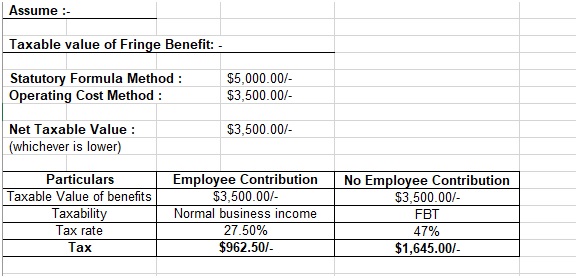What are Car Fringe Benefits?
Any non-cash benefit or incentive provided by an employer to his employees, over and above their salary or superannuation contribution, is considered as a fringe benefit. There are various types of fringe benefits. However, one of more commonly used fringe benefit is a Car Fringe Benefit.
There is a long-standing tradition of allowing employees to use business vehicles for private purposes. This may be considered as provision of Car Fringe Benefit. For more information on what is a Car Fringe Benefit, watch this short ATO video.
In the past, it has been a common practice to provide employees with non-cash benefits in lieu of their salary. This would result in evasion of tax, that would have been otherwise payable by employees on their salary income. FBT was introduced to deal with these kinds of tax evasion practices.
Allowing employees to use business vehicles for private use is a Car fringe benefit. Employers may be liable to pay Fringe Benefit Tax on taxable value of such benefits provided. The tax rate for FBT is much higher as compared to Income tax rate for the company or individuals. If you have allowed your employees to use business vehicles for private purpose during the last FBT year, now is the time to choose a proper treatment for those benefits provided, or else you may end up paying more than what you could have paid.
So how do you minimize your FBT Liability?
Don’t let the Fringe “Benefit” provided by you to your employee turn out to be a “Disbenefit” for you.
ATO has listed 2 methods for calculating the taxable value of a Car Fringe Benefit.
- Operating Cost / Log Book Method: – If the employee uses business vehicle for private as well as work related purposes, they should maintain a log book for 12 weeks to demonstrate the work use vs private use %. The FBT will then only be charged on the private portion of vehicle expenses, including fuel, insurance, repairs and services, deemed depreciation and interest. This is known as the “operating cost” method.
- Statutory Formula Method: – If no log book is maintained, FBT is charged on a nominal value of 20% of the vehicle’s original cost (less a 1/3 discount if the vehicle is over 4 years old). This is known as the “statutory formula” method and can lead to a higher FBT liability than the operating cost method if the vehicle is partially used for work related purposes.
You can adopt any of the above methods, whichever is beneficial for you i.e. results in a lower taxable value. And the method for calculating taxable value may be changed from year to year. FBT is then calculated on the taxable value of benefit derived using one of the above methods.
Employee Contribution – Key to minimizing your Car FBT liability: –
As per ATO, if an employee makes a contribution towards the benefit being provided, then the employer will not be liable to pay FBT on those benefits. Now, this is more beneficial from tax savings point of view. Instead of paying FBT, it is preferable to receive contribution from employee for the benefits received. An example is not the best way of understanding, in fact, it is the only way of understanding. So, let us understand how employee contributions are beneficial as compared to FBT, using an example as shown below: –
Example: –

As shown above, if we go with employee contribution, $3,500.00/- will be treated as “Other Income” in the books of employer and it will be taxable in the hands of company at normal tax rate of 27.5%.
But if there is no employee contribution, then the same will be treated as Car fringe benefit provided to employee and for this FBT will have to be paid at a higher tax rate of 47%. Also, FBT return will be required to be lodged resulting higher accounting fees.
Hence Employee contribution is beneficial for minimizing your Car FBT liability.
For tailored advice on how to achieve the best outcomes for your business in the FBT year, please get in touch with our team at Optimisers KPO Pvt Ltd.
Jimit Doshi, CA
Account Executive
Optimisers KPO Pvt Ltd
Contact: weare@optimisers.com.au

